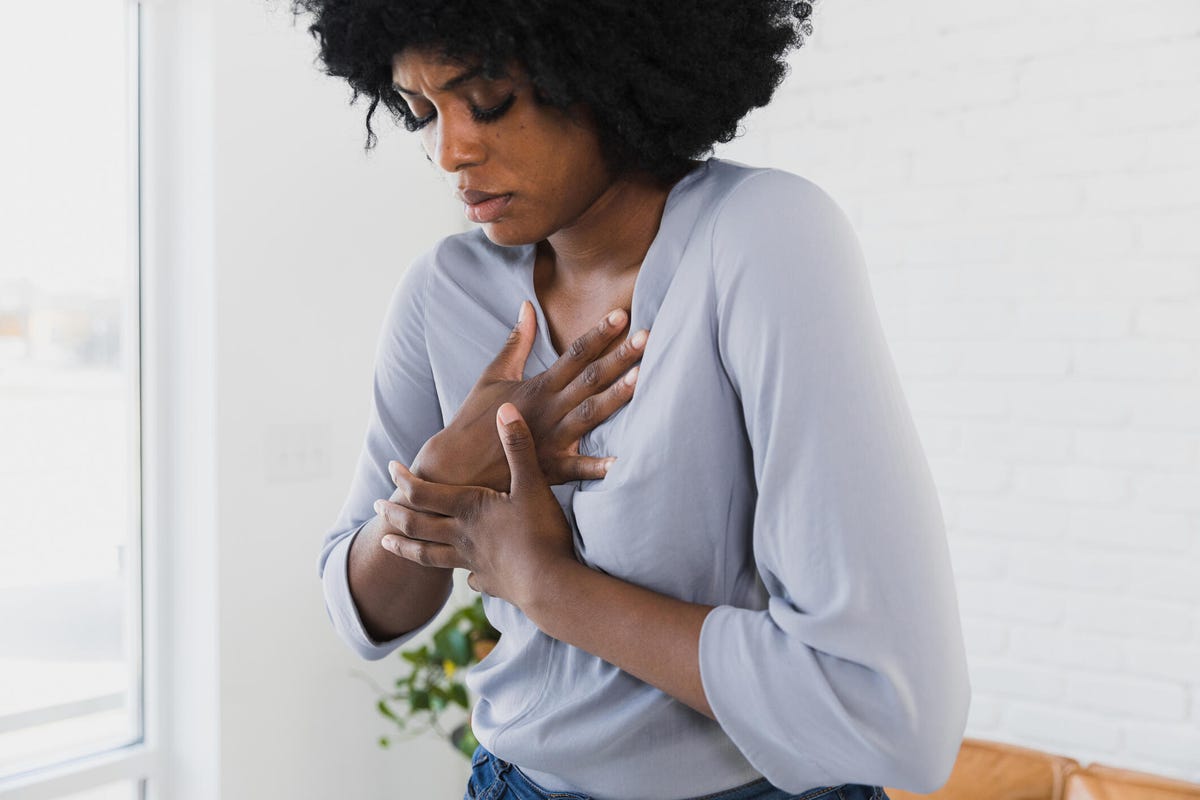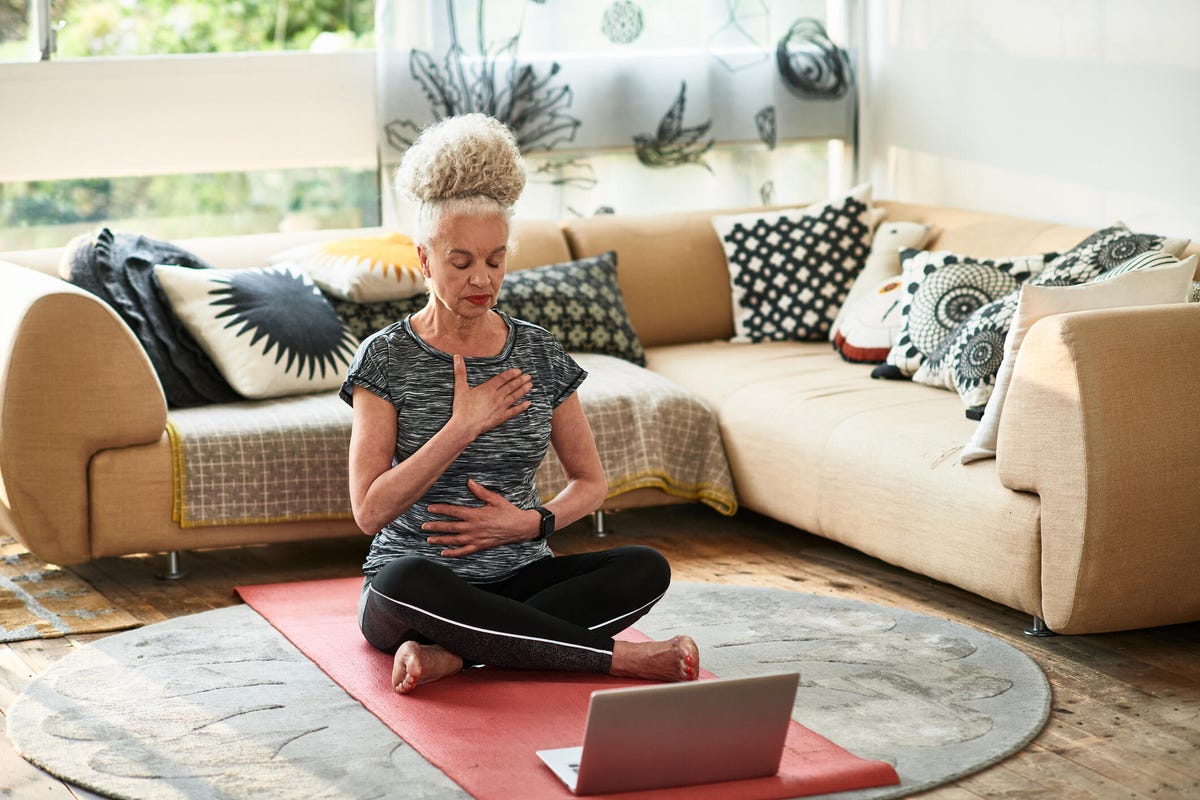
An estimated 40 million adults in the US have anxiety and experience symptoms including nervousness, rapid breathing and a pounding heart. Those are the typical anxiety symptoms that many people are familiar with. One lesser known symptom is chest pain.
Tightness in the chest is often a physical manifestation of panic or anxiety attacks. According to a 2018 study, 30 to 40% of visits to the emergency room for chest pain unrelated to a heart attack are due to anxiety. Here's everything you should know about anxiety chest pain and how to tell it apart from a heart attack.
Why does anxiety cause tightness in the chest?
Anxiety is our body's natural response to stress. When we experience fear, our autonomic nervous system's fight-or-flight response is activated to protect us. This response includes both brain and body changes. Our brains are flooded with adrenaline and cortisol, while physical changes include sweating, shortness of breath or tightening muscles. As muscles tense and your heart rate increases, you may begin to hyperventilate and contribute to chest pain.
What does anxiety chest pain feel like?
Chest pain is a common symptom of panic attacks. Tightness in the chest caused by anxiety can present in several ways. For some, the onset of chest discomfort may be gradual, while others may feel it very quickly.
Common descriptions of anxiety chest pain include:
- Tightness or tension in the chest
- Sharp, stabbing or shooting pains
- Persistent chest aching
- Numbness or a dull ache in the chest
- Muscle twitches or spasms
If you haven't experienced tightness in the chest from anxiety, it can be an alarming experience. For many, the symptoms seem very similar to a heart attack. While they are similar, there are significant differences between the two.

What's the difference between a panic attack and a heart attack?
Sometimes it can be difficult to differentiate anxiety chest pain from other types of chest pain, especially if you're predisposed to heart attacks or other cardiac conditions. Heart attacks result from blockages in the coronary artery.
The most significant and identifiable difference between tightness in the chest from anxiety and a heart attack is the location of the pain. Most often, pain and tightness from anxiety are located in the chest while heart attack pain travels to other parts of the body -- like down your arm or to your shoulder. How you experience chest pain is also different. Anxiety chest pain tends to feel sharper, while heart attack chest pain has been described as heavy pressure or tightness. Another important difference is when these attacks occur -- heart attacks are more likely to occur during exertion, whereas panic attacks frequently happen during rest.
If you're experiencing chest pain, it's best to seek medical treatment, even if it's associated with anxiety. It's better to know and address your anxiety than risk it being something more serious that goes untreated.
What's the difference between anxiety and a panic attack?
The terms panic attack and anxiety are often used interchangeably, though they are two very different experiences, especially when discussing chest pain. Daily anxiety typically doesn't usually result in chest pain for most people. Panic and anxiety attacks are more severe and can be debilitating while they are happening. Tightness in the chest is one of the most common symptoms of a panic attack or a panic disorder.
Another distinction to make is between an anxiety attack and a panic attack. Anxiety and panic attacks are similar, though anxiety attacks are generally less intense and brought on by a specific trigger. Panic attacks can occur with seemingly no source. Panic attacks can last anywhere from 5 to 20 minutes. The duration and frequency will depend on the severity of your panic disorder.
How to get rid of tightness in the chest from anxiety
Getting rid of chest pain can be difficult at the moment. However, these simple tactics can help you regain control over the situation.
Recognize what's happening
When you are experiencing anxiety or panic attack symptoms, it's important to recognize they are happening and accept them -- it will help you work through what you are experiencing. Recognition can also help you determine what decisions to make about the situation. If you realize you're overstimulated, you can remove yourself from the situation to manage symptoms.
Focus on your breathing
Calming breathing exercises can help neutralize the shortness of breath or increased heart rate symptoms associated with anxiety. Focusing on breathing can help you end the stress response. You should expect it to take a few minutes of intentional breathing to feel relief. You can use breathing exercises and techniques anywhere, as often as needed.
Common breathing exercises for anxiety:
- 4-7-8 breath: This simple yet effective breathing technique can reduce stress. To perform 4-7-8, inhale for four counts, hold the breath for seven counts and exhale for eight counts.
- The box breath: Box breath is used to slow your breathing. Start by exhaling fully, inhale four counts, hold for another four counts, then exhale for another four counts. Repeat the process three to four times.
- Belly breathing: Also known as diaphragm breathing, bellying breathing offers a deep sense of relaxation. To practice, place your left hand over your heart and then your right hand over your belly. Inhale slowly and feel your belly expand. Then exhale slowly and feel your belly contract.

Use the 3-3-3 technique
Sometimes, you're able to catch anxiety symptoms creeping up. You can use the 3-3-3 anxiety technique to curb physical symptoms. Using this technique can help you feel grounded and more in control. It's simple to do and an effective way to distract yourself from triggers that may be causing anxiety and redirect your focus.
Here's how to use the 3-3-3 rule:
1. Name three things that you can see around you. Focus on what they are and take note of identifying characteristics like their color and texture.
2. Next, name three things you can hear. Are they high-pitched or loud?
3. Finally, choose three parts of your body to move.
Seek therapy
Short-term techniques to help you manage anxiety symptoms at the moment are essential. However, they don't treat the underlying cause of your anxiety. When anxiety attacks or chest pain from anxiety symptoms becomes a regular occurrence, it's time to speak with a doctor. Working with a therapist and cognitive behavioral therapy will be able to help identify triggers and equip you with adequate coping methods. Coping techniques will help you feel more confident and in control of the situation, which can lessen symptoms. CBT uses multiple techniques to identify and reprogram negative thoughts and behaviors that trigger anxiety.
CBT is an effective treatment for the following conditions:
- Panic disorder
- Generalized anxiety disorder
- Social anxiety disorder
- Obsessive-compulsive disorder
- Post traumatic stress disorder
- Prolonged grief disorder
Too long; didn't read?
Tightness in the chest anxiety can be alarming, especially if you've never experienced it. In-the-moment techniques such as deep breathing and the 3-3-3 rule can help but not solve the issue. When anxiety or panic attacks are the sources of your chest tightness, it's best to treat the underlying cause of what is making you anxious.
You should see a medical doctor immediately if:
- The tightness in your chest lasts longer than 10 minutes.
- The pain begins to radiate out from your chest and into your arms.
- You begin to develop other physical symptoms.
The information contained in this article is for educational and informational purposes only and is not intended as health or medical advice. Always consult a physician or other qualified health provider regarding any questions you may have about a medical condition or health objectives.









 Add Category
Add Category